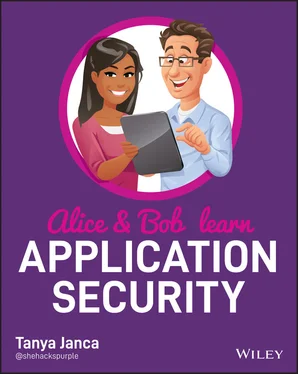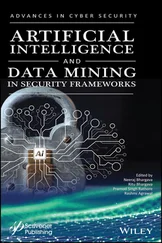237 240
238 241
239 242
240 243
241 244
242 245
243 246
244 247
245 248
246 249
247 250
248 251
249 252
250 253
251 254
252 255
253 256
254 257
255 iv
256 v
257 vii
258 ix
259 xi
260 258

Alice & Bob Learn Application Security
Tanya Janca

Why application security? Why should you read this book? Why is security important? Why is it so hard ?
If you have picked up this book, you likely already know the answer to this question. You have seen the headlines of companies that have been “hacked,” data breached, identities stolen, businesses and lives ruined. However, you may not be aware that the number-one reason for data breaches is insecure software, causing between 26% and 40% of leaked and stolen records (Verizon Breach Report, 2019). 1Yet when we look at the budgets of most companies, the amount allocated toward ensuring their software is secure is usually much, much lower than that.
Most organizations at this point are highly skilled at protecting their network perimeter (with firewalls), enterprise security (blocking malware and not allowing admin rights for most users), and physical security (badging in and out of secure areas). That said, reliably creating secure software is still an elusive goal for most organizations today. Why?
Right now, universities and colleges are teaching students how to code, but not teaching them how to ensure the code they write is secure, nor are they teaching them even the basics of information security. Most post-secondary programs that do cover security just barely touch upon application security, concentrating instead on identity, network security, and infrastructure.
Imagine if someone went to school to become an electrician but they never learned about safety. Houses would catch fire from time to time because the electricians wouldn't know how to ensure the work that they did was safe. Allowing engineering and computer science students to graduate with inadequate security training is equally dangerous, as they create banking software, software that runs pacemakers, software that safeguards government secrets, and so much more that our society depends on.
This is one part of the problem.
Another part of the problem is that (English-language) training is generally extremely expensive, making it unobtainable for many. There is also no clear career path or training program that a person can take to become a secure coder, security architect, incident responder, or application security engineer. Most people end up with on-the-job training, which means that each of us has a completely different idea of how to do things, with varying results.
Adding to this problem is how profitable it is to commit crimes on the internet, and with attribution (figuring out who did the crime) being so difficult, there are many, many threats facing any application hosted on the internet. The more valuable the system or the data within it, the more threats it will face.
The last part of this equation is that application security is quite difficult. Unlike infrastructure security, where each version of Microsoft Windows Server 2008 R2 PS2 is exactly the same, each piece of custom software is a snowflake; unique by design. When you build a deck out of wood in your backyard and you go to the hardware store to buy a 2x4 that is 8 feet long, it will be the same in every store you go to, meaning you can make safe assumptions and calculations. With software this is almost never the case; you must never make any assumptions and you must verify every fact. This means brute-force memorization, automated tools, and other one-size-fits-all solutions rarely work. And that makes application security, as a field, very challenging.
If you look at the System Development Life Cycle (SDLC) in Figure I-1, you see the various phases moving toward the right of the page. Requirements come before Design, which comes before Coding. Whether you are doing Agile, Waterfall, DevOps, or any other software development methodology, you always need to know what you are building (requirements), make a plan (design), build it (coding), verifying it does all that it should do, and nothing more (testing), then release and maintain it (deployment).

Figure I-1 :System Development Life Cycle (SDLC)
Often security activities start in the release or testing phases, far to the right, and quite late in the project. The problem with this is that the later in the process that you fix a flaw (design problem) or a bug (implementation problem), the more it costs and the harder it is to do.
Let me explain this a different way. Imagine Alice and Bob are building a house. They have saved for this project for years, and the contractors are putting the finishing touches on it by putting up wallpaper and adding handles on the cupboards. Alice turns to Bob and says, “Honey, we have 2 children but only one bathroom! How is this going to work?” If they tell the contractors to stop working, the house won't be finished on time. If they ask them to add a second bathroom, where will it go? How much will it cost? Finding out this late in their project would be disastrous. However, if they had figured this out in the requirements phase or during the design phase it would have been easy to add more bathrooms, for very little cost. The same is true for solving security problems.
This is where “shifting left” comes into play: the earlier you can start doing security activities during a software development project, the better the results will be. The arrows in Figure I-2show a progression of starting security earlier and earlier in your projects. We will discuss later on what these activities are.

Figure I-2 :Shifting/Pushing Left
This book will teach you the foundations of application security (AppSec for short); that is, how to create secure software. This book is for software developers, information security professionals wanting to know more about the security of software, and anyone who wants to work in the field of application security (which includes penetration testing, aka “ethical hacking”).
If you are a software developer, it is your job to make the most secure software that you know how to make. Your responsibility here cannot be understated; there are hundreds of programmers for every AppSec engineer in the field, and we cannot do it without you. Reading this book is the first step on the right path. After you've read it, you should know enough to make secure software and know where to find answers if you are stuck.
Notes on format: There will be examples of how security issues can potentially affect real users, with the characters Alice and Bob making several appearances throughout the book. You may recall the characters of Alice and Bob from other security examples; they have been being used to simplify complex topics in our industry since the advent of cryptography and encryption.
Читать дальше
















